This document describes the use of major cover crops grown in southern Florida. The intent of this document is to identify promising cover crops adaptable to Florida's climate. Identified cover crops must also contribute to nutrient conservation and improve soil organic matter by incorporation of cover crop biomass. This document also includes discussion of other aspects of cover crop use in the vegetable production systems of south Florida.
The target audience for this document includes vegetable producers and other agricultural producers whose land is idle for several months during summer. Certified Crop Advisers, farm consultants, and other parties interested in nutrient and soil conservation practices that address agricultural sustainability in Florida may also find this information of value. For growers with short-term leases, cover crops may not be financially advantageous without additional arrangements with the landowner.
Cover Crop Overview
A cover crop is planted for the purpose of covering a bare land and protecting the soil, and in some cases for scavenging residual nutrients that were not taken up by the previous crop. Cover crops can either be crops grown between cash-crop cycles, such as vegetables, or intercropped with the cash crops (Figure 1), e.g., to cover the bare ground in orchards, groves, and other perennial crops.
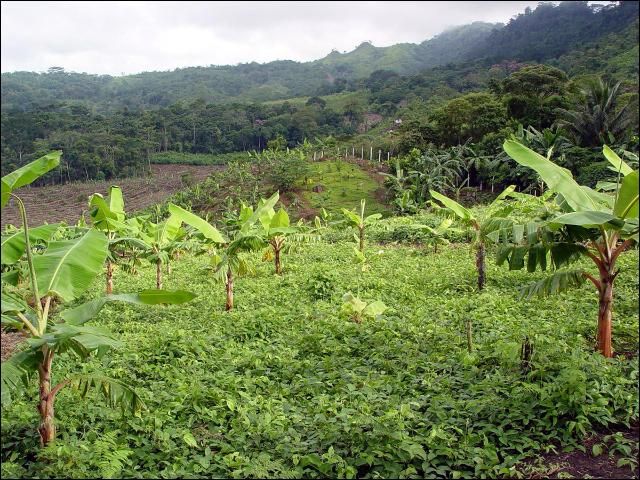
Credit: Y. C. Li, UF/IFAS
Cover crops may also be grown as green manure (Figure 2). A cover crop used as green manure is usually incorporated into the soil while still green or just before it sets seed. This practice recycles nutrients that are contained within the green manure crop and contributes organic matter to the soil for improving its fertility.

Credit: Y. C. Li, UF/IFAS
For the purposes of this document, cover crops were produced with minimal inputs. No irrigation or fertilization was necessarily applied to any of the crops described herein. Additionally, no pesticides or herbicides were needed to protect these cover crops.
Typically, vegetable growers are facing challenges with low soil organic matter and coarse-textured soils (usually less than 2% organic matter), which contributes to low nutrient- and water-holding capacities within these soils. Such soils are usually composed of sands (Figure 3) or gravels (Figure 4). These coarse particles further contribute to low water- and nutrient-holding capacities. Both gravel and sandy soils pose wind erosion problems for seedlings and transplants. Selected cover crops can address this problem by acting as windbreaks, or just by providing additional organic matter to hold soil particles in place, which reduces the quantity of loose soil particles available for wind erosion.

Credit: UF/IFAS
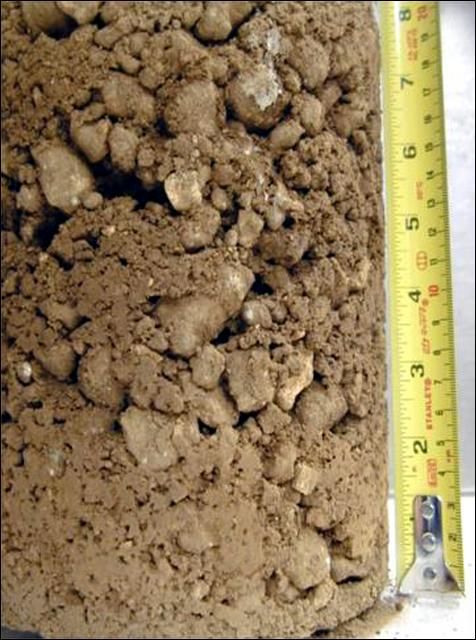
Credit: R. Muñoz-Carpena, UF/IFAS
The sandy or gravelly soils of Florida often have native soil pH ranges that are either too high or too low for optimum vegetable crop production. For example, plant available iron (Fe), one of the essential micronutrients, is often deficient in high pH soils (e.g., calcareous soil), while phosphorus (P) can be limited in soils with either too high or too low pH. These pH extremes and their effects on nutrients can be partially offset by the input of organic matter supplied by cover crop biomass.
In addition to having poor water-holding capacity and low nutrient availability, vegetable land with coarse soil may also be affected by parasitic nematodes. Nematodes often adversely affect vegetable crop production by causing damage to the roots and further restricting both water and nutrient uptake by the plant (Figure 5). Certain grassy or leguminous cover crops strongly suppress plant-parasitic nematodes. However, a given cover crop may not be effective against all species of parasitic nematodes in a region.
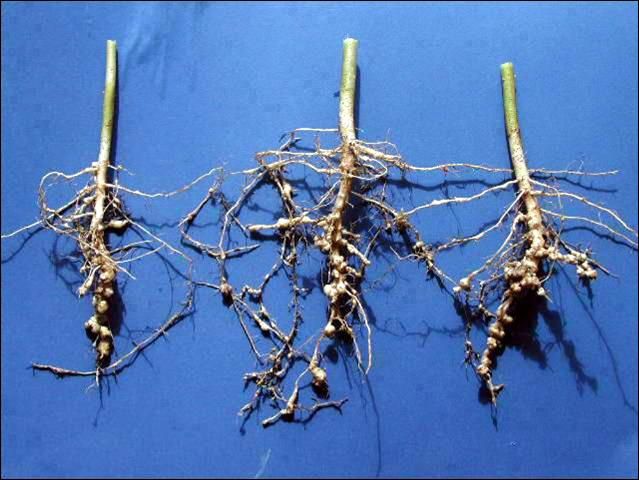
Credit: Q. Wang, UF/IFAS
Sorghum sudangrass [S. bicolor × S. bicolor var. sudanense (Piper) Stapf.]
Sorghum sudangrass, also known as sorghum Sudan (Figure 6), has been used as a cover crop throughout Florida at one time or another, and it is still grown by some growers, especially bean growers, during the fallow summer period in south Florida. Sorghum sudangrass usually produces 5 to 7 tons dry mass per acre. Since 0.92 percent of this material is nitrogen, the amounts of nitrogen potentially available to the subsequent cash crop range from about 90 to 130 pounds per acre. However, sorghum sudangrass can be used as a good cover crop to scavenge the leftover soil nutrients applied to the previous crop, and it is a good option to rotate with leguminous cash crops, such as green beans, in Florida. This plant grows poorly in some Florida soils with a poor tolerance to flooding, as it has been developed for the finer textured soils in the Midwest and Southwest. Sorghum sudangrass often grows quite tall, requiring mowing to prepare the crop for green manuring, which adds cost to the crop, though it can be good forage. Its large fibrous stems have a high carbon to nitrogen ratio (C:N), which slows decomposition and may immobilize nitrogen from the soil during the decomposition process by microorganisms. Lastly, Sorghum sudangrass often attracts armyworms and corn silk flies, which may be detrimental to certain types of subsequent vegetable crops. Even so, sorghum sudangrass can suppress weeds and some parasitic nematodes, and the seed is inexpensive (less than $1.00 per pound).
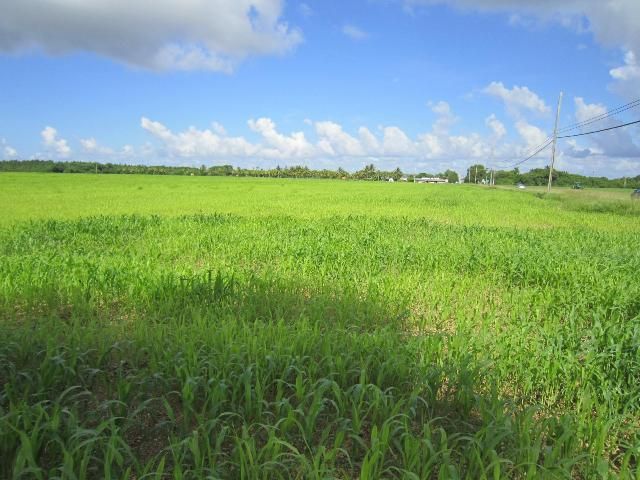
Credit: Q. Wang, UF/IFAS
Sunn hemp (Crotalaria juncea L. cv. 'Tropic Sun')
Sunn hemp (Figure 7 and Figure 8) has a number of advantages compared to Sorghum sudangrass as a cover crop. This plant is an annual tropical legume that has a fast, 60- to 80-day production cycle, during which the plant may exceed 6 feet in height. Sunn hemp is a short-day-length plant that is quite drought-tolerant, grows well in both high- and low-pH soils, and is also resistant to root-knot nematodes. Typically, sunn hemp produces 6 to 8.5 tons of dry biomass per acre. Since 2.85 percent of this material is nitrogen, the amounts of nitrogen potentially available to the subsequent cash crop range from about 340 to 480 pounds per acre. However, sunn hemp does have several limitations. Seeds used to be rather high-priced (up to $4.00 per pound) due to import costs and limited availability, but in recent years it is about $1.40 to $1.60 per pound. Seeds require Rhizobium inoculation before planting to improve nitrogen fixing efficiency. In some fields, sunn hemp stands may be reduced due to damping-off from Pythium or a form of Fusarium. Even with these possible limitations, sunn hemp is among the best of the tested cover crops in southern Florida conditions.

Credit: Y. C. Li, UF/IFAS
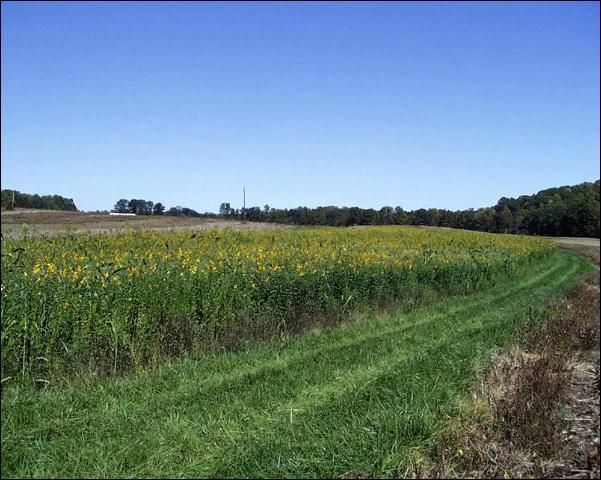
Credit: Y. C. Li, UF/IFAS
Velvetbean (Mucuna deeringiana (Bort.) Merr.)
Velvetbean (Figure 9) is another annual tropical legume that produces a large amount of biomass, is drought tolerant, suppresses parasitic nematodes, and grows well in both high- and low-pH soils. Velvetbean may produce 5 to 7 tons per acre of dry biomass consisting of 2.6 percent nitrogen, which may provide from 260 to 360 pounds of nitrogen to the subsequent cash crop. However, velvetbean's large seed requires a special planter, and volunteer plants may persist into the next cash crop if not terminated on time, requiring weed control. However, a small seeded cultivar, 'Georgia bush', can be seeded with some conventional planters. The bush type cultivar is preferred because of its short vine as compared to long and tangle vines. Additionally, velvetbean may be potentially allelopathic to some weeds and subsequent vegetable crops. In field trials of south Florida, velvetbean has been ranked among the best of the tested cover crops.

Credit: Q. Wang, UF/IFAS
Cowpea (Vigna unguiculata L. cv. 'Iron Clay')
Cowpea is a legume that grows well in a variety of soils. It is resistant to root-knot nematodes and has a short growing season of 40 to 50 days. Cowpea may produce 3 to 5 tons per acre of biomass consisting of 2 percent nitrogen, which may provide from 120 to 200 pounds of nitrogen to the subsequent cash crop. However, in southern Florida conditions, cowpea is not tolerant to flooding and produces a rather low biomass if managed inappropriately. In addition, volunteer plants can be a concern if the plants are terminated too late when seeds have fully developed.
Aeschynomene (Aeschynomene evenia C. Wright)
Aeschynomene grows well on calcareous soils in southern Florida and is a warm-season legume forage. It is resistant to root-knot nematodes as well. Aeschynomene's single apparent disadvantage for southern Florida conditions is its low biomass production.
Sesbania (Sesbania exaltata Raf.)
Sesbania, like aeschynomene and cowpea, is a warm-season legume forage that is well adapted to Florida conditions. However, sesbania is susceptible to root-knot nematodes and does not quickly form a closed canopy, competing rather poorly with some of Florida's persistent weeds.
German millet (Setaria italica (L.) P. Beav.) and Japanese pearl millet (Pennisetum glaucum)
Both German millet and Japanese pearl millet grow well in southern Florida and they have been proven to be resistant to root-knot nematodes; however, like some of the other tested crops, German millet produces low biomass, and the coverage of bare land is not perfect.
Buckwheat (Fagopyrum esculentum)
Buckwheat or common buckwheat is another promising candidate of cover crops in south Florida. Despite its name, buckwheat is not closely related to wheat. It is not a cereal, nor is it even a member of the grass family. Buckwheat is related to sorrel, knotweed, and rhubarb, and is known as a pseudocereal because its seeds' culinary use is the same as cereals, owing to their composition of complex carbohydrates. The plants can adopt the tropical or subtropical climate and soil conditions with a short season growth. Buckwheat plants grow to about 20 to 30 inches tall in south Florida, and produce beautifully white flowers (Figure 10), and the seed is in a triangular shape. It can establish quickly to cover the land, which suppresses summer weeds, and can be a promising cover crop in summer to fit a small slot of the vegetable off-season before growing non-legumes, such as beans.
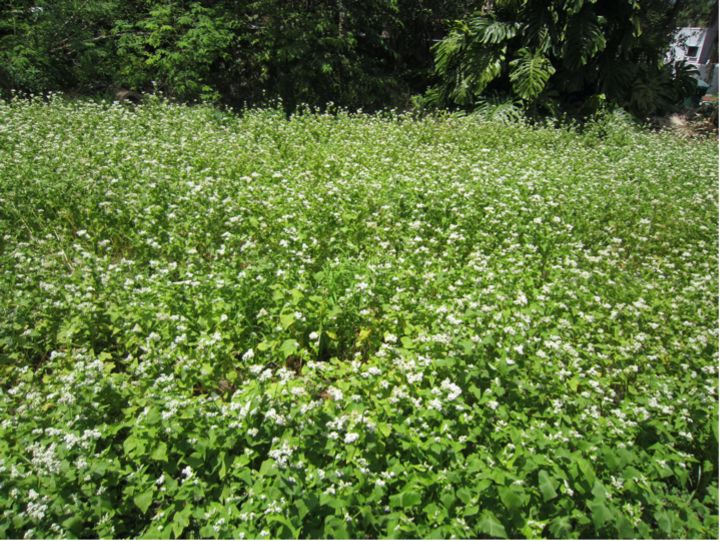
Credit: Q. Wang, UF/IFAS
Measured Effects of Selected Cover Crops in Southern Florida Conditions
As stated above, cover crops can capture residual nutrients during their growing cycle and subsequently make these nutrients available for the following vegetable crops. This process retains nutrients in the field, which is a well-recognized Best Management Practice (BMP). When cover crops are incorporated into the soil (green manuring), they can contribute a considerable amount of organic matter and plant nutrients to the soil (shown as Dry Matter in Table 1) and improve soil fertility. Typically, production of approximately 5 tons dry matter per acre is equivalent to raising the organic matter of the soil in a six-inch layer by 1% (This calculation assumes that a 6-inch layer of soil weighs 2,000,000 pounds per acre, a typical value for a sandy soil). Since many of Florida's soils have between 2 and 3% organic matter, this 1% increase is a substantial change. Because of Florida's hot and humid climate, this additional organic matter will be broken down rather quickly. Nonetheless, the additional organic matter will directly contribute to the subsequent vegetable crop by both enhancing nutrient availability and improving soil water holding capacity. In almost all cases, cover crops have been proved to improve the yield and quality of the following vegetable crops substantially in south Florida field studies.
Another contribution that cover crops can make is to increase the available nitrogen associated with other plant nutrients in the soil. Legumes can convert atmospheric nitrogen to plant available forms through a symbiotic relationship with Rhizobium bacteria, further contributing to plant nutrition for subsequent vegetable crops.
Cover crops are often selected based on their rapidity of establishing, covering the ground, and producing copious amounts of biomass. With these traits, cover crops can suppress weeds and help to reduce the formation of weed-seed bank in the soil. Also, some cover crops release specific chemicals into the soil through their roots or from their shoots after decomposition, and these chemicals produce allelopathic compounds to suppress weeds, plant-parasitic nematodes, and some pathogens. Weed suppression greatly benefits subsequent cash crops, which often experience decreased weed competition and herbicide application. Decreasing the weed population may also reduce pest pressures on vegetables because some weeds often serve as hosts for insects or disease pathogens.
Parasitic nematode infestation is a frequent problem for vegetable production in Florida. Some cover crops can effectively reduce the harmful effects of root-knot nematodes, preventing yield loss or avoiding total crop failure. Certain cover crops have shown to reduce populations of the following harmful nematodes: Helicotylenchus, Meloidogyne (root-knot, a major parasitic nematode of bean, tomato, and okra plants), Pratylenchus, Rotylenchulus reniformis, and Quinisulcius.
Unsuitable Cover Crops for South Florida
A number of other cover crops have been tested in southern Florida and found to be unacceptable (Table 2), though some of these do quite well in the northern part of the state. Some grow poorly in southern Florida conditions, while others are not suited for commercial use for one reason or another. For example, a cover crop may become a weed in the subsequent vegetable production cycle, or the cover crop may enhance nematode populations, thereby adversely affecting the subsequent vegetable production cycle.
Potential Cover Crops for South Florida
There are a number of additional crops that are being used in other parts of the United States as cover crops. These crops have not been tested in southern Florida conditions and cropping systems; however, future research will address these crops (Table 3). As research progresses, UF/IFAS will schedule field days (Figure 11) to demonstrate new cover crops and equipment that might be associated with their production and management. Because nutrient and pest management are linked directly to BMP activities, the use of cover crops in an effective and cost-efficient manner is important to the sustainability of Florida agriculture.
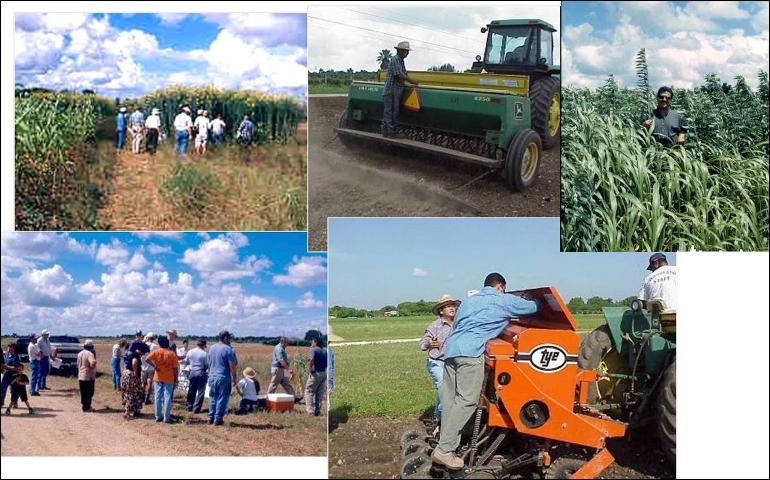
Credit: Q, Wang, UF/IFAS
Summary
Cover crops are an effective way to retain soil nutrients for subsequent vegetable crops and, thus, they are an important approach to be included in BMPs for south Florida. These tested cover crops can also suppress weeds and soil-born pests, such as parasitic nematodes, and can return a significant quantity of dry biomass to the soil, substantially improving nutrient- and water-holding capacities of the soil. Marketable vegetable yields and quality can be improved from following a cover crop, making the use of these crops worthwhile to vegetable producers. While no cover crop is without some limitations, field research trials in south Florida have demonstrated that sunn hemp and velvetbean as legumes and sorghum sudangrass as non-legume are superior to the other tested cover crops in the cropping system.
For Further Reading
The following EDIS publications deal with related issues and may be of interest to the reader. Please visit the EDIS website at https://edis.ifas.ufl.edu.
Chambliss, C. G., R. M. Muchovej, and J. J. Mullahey. 2003. Cover Crops. Gainesville: University of Florida Institute of Food and Agricultural Sciences. https://edis.ifas.ufl.edu/aa217
Dunn, R. A. 2003. Soil Organic Matter, Green Manures and Cover Crops For Nematode Management. Gainesville: University of Florida Institute of Food and Agricultural Sciences. https://edis.ifas.ufl.edu/vh037
Rich, J. D. Wright, J. Marois, and D. Sprenkel. 2003. Selected Legumes Used As Summer Cover Crops. Gainesville: University of Florida Institute of Food and Agricultural Sciences. https://edis.ifas.ufl.edu/in483
Rouse, R. E., R. M. Muchovej, J. J. Mullahey. 2001. Guide To Using Perennial Peanut As A Cover Crop In Citrus. Gainesville: University of Florida Institute of Food and Agricultural Sciences. https://edis.ifas.ufl.edu/ch180
Wang, K. H, and R. McSorley. 2004. Management of Nematodes with Cowpea Cover Crops. Gainesville: University of Florida Institute of Food and Agricultural Sciences. https://edis.ifas.ufl.edu/in516
Cover crops that have proved to be unsuitable for southern Florida growing conditions or commercial vegetable production operations.